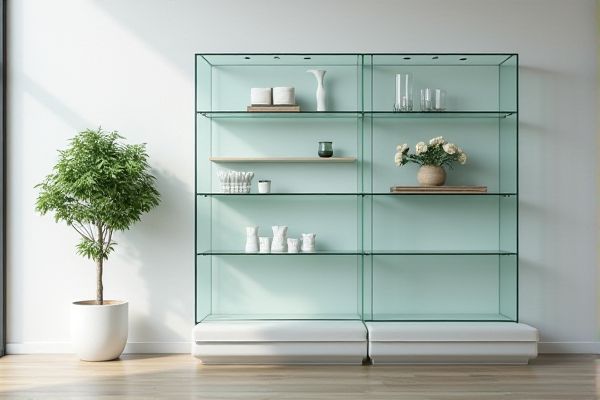
Glass shelves offer a sleek, modern look with high durability and resistance to scratches, making them ideal for displaying valuables. Acrylic shelves provide lightweight flexibility and impact resistance, perfect for versatile usage and safer environments--discover which option fits your space best by reading the full comparison.
Table of Comparison
| Feature | Glass Shelves | Acrylic Shelves |
|---|---|---|
| Material | Tempered or laminated glass | Durable acrylic plastic |
| Weight | Heavy and sturdy | Lightweight and easy to handle |
| Durability | Scratch-resistant, but can shatter | Shatterproof, prone to scratches |
| Transparency | Crystal clear, high clarity | Clear but may yellow over time |
| Maintenance | Easy to clean, resistant to stains | Requires careful cleaning to avoid scratches |
| Load Capacity | Higher weight support | Lower weight support |
| Cost | Generally more expensive | More affordable option |
| Usage | Best for modern, elegant decor | Ideal for lightweight items and casual settings |
Introduction to Glass vs Acrylic Shelves
Glass shelves offer superior clarity, durability, and scratch resistance, ideal for high-end displays and heavy items. Acrylic shelves provide lightweight, impact-resistant, and customizable options suitable for versatile interior designs and safer environments. Both materials balance aesthetics and functionality, with choices influenced by weight capacity, transparency, and maintenance preferences.
Material Overview: Glass and Acrylic Compared
Glass shelves offer superior strength, durability, and scratch resistance with a premium, clear finish ideal for modern and upscale interiors. Acrylic shelves provide lightweight, shatter-resistant alternatives with greater flexibility and easier customization options, though they may scratch and yellow over time. Choosing between glass and acrylic depends on the balance of durability, aesthetic appeal, and maintenance preferences for specific applications.
Strength and Durability Differences
Glass shelves offer superior strength and excellent resistance to scratches and heat, making them highly durable for long-term use in high-traffic areas. Acrylic shelves are lighter and more impact-resistant but prone to scratching and discoloration over time, which may require more frequent maintenance. Choosing between them depends on your need for robust durability versus lightweight flexibility in your shelving solution.
Aesthetic Appeal and Design Options
Glass shelves offer a sleek, modern aesthetic with a clear, reflective surface that enhances light flow and creates a sense of spaciousness in any room. Acrylic shelves provide greater versatility in design options, available in various colors, shapes, and thicknesses, allowing for more customized and creative displays. Your choice between these materials should consider whether you prefer the timeless elegance of glass or the bold, customizable appeal of acrylic for your interior design needs.
Weight Capacity and Load-Bearing Capabilities
Glass shelves typically offer higher weight capacity and superior load-bearing capabilities compared to acrylic shelves due to their rigidity and durability. While acrylic shelves are lighter and less prone to shattering, they can flex under heavy loads, making them less suitable for supporting substantial weight. Your choice should depend on the specific load requirements and the balance between strength and flexibility.
Safety Considerations: Breakage and Edges
Glass shelves offer a sleek and durable option but pose higher risks of breakage and sharp edges, which can cause injuries if shattered. Acrylic shelves are more impact-resistant and feature smoother, rounded edges, enhancing safety in environments with children or high activity. Your choice should weigh the balance between aesthetic appeal and the need for a safer, more resilient shelving material.
Maintenance and Cleaning Requirements
Glass shelves require regular cleaning with non-abrasive glass cleaners to maintain their clarity and prevent streaks, while acrylic shelves need gentle cleaning with mild soap and water to avoid scratches and cloudiness. Glass is less prone to staining but can be fragile, necessitating careful handling during maintenance, whereas acrylic shelves are more impact-resistant but attract dust and fingerprints more easily. Your choice between the two will depend on how much time you're willing to spend on upkeep and the cleaning methods you prefer.
Cost Comparison: Initial and Long-Term Value
Glass shelves typically have a higher initial cost compared to acrylic shelves due to the material's weight, durability, and manufacturing process. Acrylic shelves offer a more budget-friendly upfront price but may incur additional expenses over time due to increased susceptibility to scratches and discoloration. Considering long-term value, glass shelves provide greater durability and resistance to wear, making them a cost-effective investment despite the higher initial price.
Installation Process and Versatility
Glass shelves require precise mounting hardware and professional installation to ensure stability and safety due to their weight and fragility, while acrylic shelves offer easier DIY installation with lightweight brackets and simple drilling. Acrylic shelves provide greater versatility, being easily cut and shaped into various sizes and designs, whereas glass shelves are limited to standard thicknesses and profiles for structural integrity. Both materials support customizable configurations, but acrylic's adaptability makes it preferable for dynamic or creative interior applications.
Best Use Cases for Glass and Acrylic Shelves
Glass shelves excel in modern bathrooms and kitchens where durability and a sleek, transparent aesthetic are essential, supporting heavy items like glassware and toiletries. Acrylic shelves are ideal for children's rooms and retail displays due to their lightweight, shatter-resistant properties and vibrant color options. Both materials offer versatile shelving solutions, with glass prioritizing elegance and strength, while acrylic focuses on safety and customizable design.
 homyna.com
homyna.com